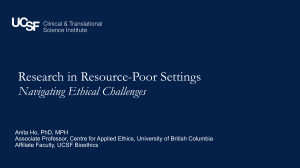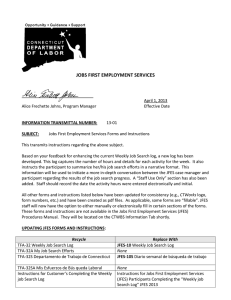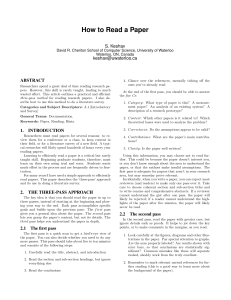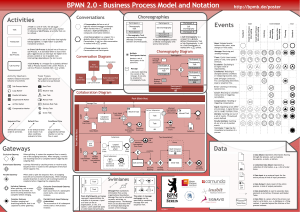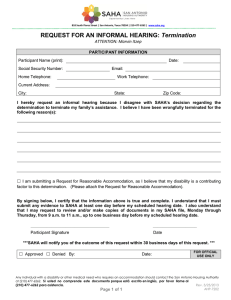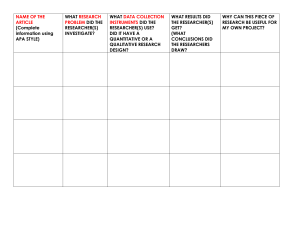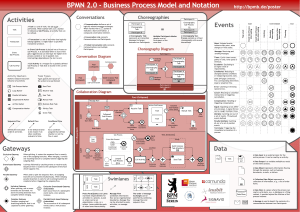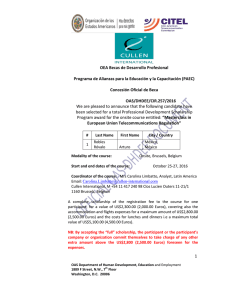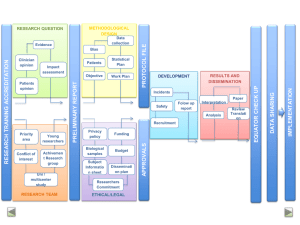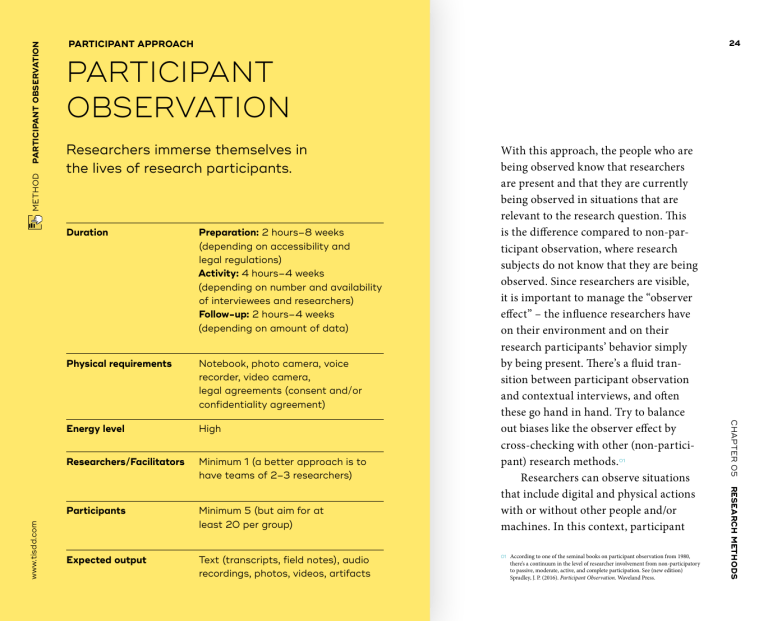
METHOD PARTICIPANT ­OBSERVATION PARTICIPANT APPROACH 24 PARTICIPANT ­OBSERVATION Researchers immerse themselves in the lives of research participants. Duration Preparation: 2 hours–8 weeks (depending on accessibility and legal regulations) Activity: 4 hours–4 weeks (depending on number and availability of interviewees and researchers) Follow-up: 2 hours–4 weeks (depending on amount of data) Physical requirementsNotebook, photo camera, voice recorder, video camera, legal agreements (consent and/or confidentiality agreement) High www.tisdd.com Researchers/FacilitatorsMinimum 1 (a better approach is to have teams of 2–3 researchers) ParticipantsMinimum 5 (but aim for at least 20 per group) Expected outputText (transcripts, field notes), audio recordings, photos, videos, artifacts 01 According to one of the seminal books on participant observation from 1980, there’s a ­continuum in the level of researcher involvement from ­non-participatory to passive, moderate, active, and complete participation. See (new edition) Spradley, J. P. (2016). P ­ articipant Observation. Waveland Press. CHAPTER 05 RESEARCH METHODS Energy level With this approach, the people who are being observed know that researchers are present and that they are currently being observed in ­situations that are relevant to the research question. This is the difference compared to non-participant observation, where research subjects do not know that they are being observed. Since researchers are v­ isible, it is important to manage the “observer ­effect” – the influence researchers have on their ­environment and on their research participants’ behavior simply by being present. There’s a ­fluid transition between participant o ­ bservation and contextual interviews, and often these go hand in hand. Try to balance out biases like the observer effect by cross-checking with other (non-participant) research methods. 01 Researchers can observe situations that include digital and physical actions with or without other people and/or machines. In this context, participant METHOD PARTICIPANT ­OBSERVATION 25 observation is particularly useful to understand cross-channel experiences, as the method focuses on people and not on one particular channel. Depending on the research question and context, observations might be at the participants’ workplace, in their homes, or even following them throughout a process like a holiday trip. During participant observations it is ­i mportant to observe not only what people are doing, by interpreting their body language and gestures, but also what people are not doing (e.g., do they ignore instructions or refrain from asking for help or assistance?). ▶ A www.tisdd.com A When researchers conduct participant observations, they often switch between rather passively ­observing situations and actively asking questions to get a deeper understanding of user needs. B Humor sometimes helps to create trust between researchers and participants. Trust is particularly important for longer participant observations. CHAPTER 05 RESEARCH METHODS B METHOD PARTICIPANT ­OBSERVATION 26 Step-by-step guide 1 Define specific research question Define your research question or a set of questions about what you want to find out. Consider why you are doing ­research (­exploratory vs. ­confirmatory ­research), what you want to do with your fi ­ ndings (personas, journey maps, ­system maps, etc.), and what sample size you’ll probably need. 2 Identify participants www.tisdd.com 3 Plan and prepare Plan how you will approach your ­research participants, what expectations you will set up front, how you 4 Conduct observations During participant observation, try to ­balance out a possible observer effect by striving to influence the research ­participants as little as possible while at the same time being as close as ­necessary. Research subjects often ­consciously or unconsciously behave differently when they feel observed – it’s even worse when they are filmed or photographed. To h ­ andle this, it’s crucial to establish trust between researchers and participants during ­participant observations. This often requires more time than ­initially ­expected. You can mix ­participant ­observation with other ­methods, such as ­contextual or ­retrospective ­interviews. Use the ­situational context and ask participants to explain their specific ­activities, artifacts, ­behavior, ­motivations, needs, pains, or gains. Sometimes ­contradictions between what people say and what people do can be very revealing if you ­mirror behavior back to ­participants. During your observations, try to ­collect as much unbiased “first-level ­construct” raw data as possible. The length and depth of participant ­observations v­ aries with the r­ esearch objective: from s­ everal quick 15-minute ­observations at a ­specific ­moment in a customer ­journey to observations over several days or s­ ometimes even weeks. CHAPTER 05 RESEARCH METHODS Based on your research question, ­define criteria for selecting suitable ­participants, considering not only who you interview, but also when and where. Use s­ ampling techniques to select your ­research ­participants, and consider ­including internal experts or external ­agencies for participant recruitment. will start and end, and how much time you will plan for the p ­ articipant observation. Write up o ­ bservation guidelines based on what you want to find out. Also consider who you want to include as researchers from the client side or from other ­departments involved in the project. Agree on how you’ll document the observations and set up legal agreements if necessary, to take voice recordings, photos, or videos, ­besides your field notes. METHOD PARTICIPANT ­OBSERVATION 27 5 Follow-up www.tisdd.com Variants Participant observation is an umbrella term for a variety of methods, such as shadowing, a day in the life, or workalong. The main ­differences between these methods are based on who —— A day in the life uses participant ­observation to understand the everyday lives of people (­mostly customers) over a certain time span, from a few hours up to ­several days. It is useful to develop or validate personas as well as to understand the wider context of customer needs. Researchers mostly focus on c­ ustomers’ routines, ­rituals, behaviors, ­environment, ­interactions, and ­conversations, or p ­ roducts ­customers use during the day. “A day in the life” often uses a c­ ombination of participant ­observation with contextual or r­ etrospective ­interviews to ­understand the reasons behind why ­subjects do c­ ertain a­ ctivities, their ­motivations and attitudes. Often, the ­research is ­visualized in the form of a j­ ourney map to show the a­ ctions of a ­customer during that day in a t­ imeline or as a system map to visualize the ­various stakeholders that c­ ustomers ­interact with during a day. —— W ork-along focuses on employees in their work environment to ­understand their daily routines and informal n ­ etworks. Work-alongs are mostly a mix of ­participant ­observation and c­ ontextual interviews, but can also ­include call ­monitoring, virtual ­ethnography, and ­non-participant ­observation. Researchers often b ­ ehave as t­ rainees or interns and work t­ ogether with ­employees for several days. They look over e­ mployees’ shoulders to learn about their e­ veryday work routines and their interactions and ­conversations with ­fellow employees, clients, ­customers, and ­other ­stakeholders, ▶ CHAPTER 05 RESEARCH METHODS Write up your individual key learnings right after the observations and ­compare them within your team. Keep track of all your ­documentation (e.g., by ­indexing your field notes, ­transcripts, ­photos, audio and ­video ­recordings, ­and collected artifacts) and ­highlight important passages. For each participant ­observation, write a short summary that includes your conflated key findings as well as raw data to exemplify these, such as quotes, photos, or videos. Don’t forget to link the s­ ummary to your u ­ nderlying data (that’s where ­indexing comes in very handy). you observe (e.g., work-along) and if you follow ­research subjects over time (e.g., a day in the life) and sometimes also through ­different physical spaces (e.g., shadowing). However, the terms overlap to a large extent and are often used interchangeably: to understand ­internal processes as well as formal and informal ­networks, corporate culture, and ­tone of voice. Researchers should pay attention to the workarounds ­employees use to cope with existing ­corporate ­structures and ­processes. Often, looking at the sticky notes you find around the workplace is a great start to ­understand the hacks and ­shortcuts people use to operate more ­efficiently. Researchers need to be s­ ensitive to their work-along ­participants, as their presence can be very invasive at times. Also, the presence of ­researchers often affects ­people’s ­behavior (the ­observer or Hawthorne effect),01 so ­researchers should be mindful of this. To enrich data ­collected during a ­work-along, researchers can collect artifacts, such as instructions, internal documents, catalogues, emails, ­transcripts, and so on. 01 See #TiSDD 5.1.3, Data collection, for more information on potential biases. —— Shadowing refers to researchers ­following research subjects (mostly ­customers) over time and often also through the p ­ hysical spaces of their lives, like a ­shadow, in order to observe their b ­ ehavior and ­understand their p ­ rocesses and e­ xperiences. Shadowing is often much shorter than a work-along, s­ ometimes lasting only a few minutes, or up to several hours. It is important to clarify researcher s­ tatus and boundaries with all ­participants ­before you start your ­research. Shadowing ­enables ­researchers to gain an ­in-depth ­understanding of e­ xperiences from the p ­ articipants’ perspective. It n ­ ormally also includes contextual ­interviews at critical moments (e.g., when a ­customer has a problem or s­ omeone uses an i­ nteresting workaround). Often, the ­research ­participants themselves wouldn’t ­recognize a critical ­situation as such, since they are a­ ccustomed to it (e.g., c­ ommon p ­ roblems they have ­every day). Shadowing will reveal insights you won’t find with mere i­ nterviews – ­either because ­participants do not tell the truth (e.g., due to social ­pressure) or simply because they are not aware of their own behavior. Method notes → If research participants communicate or retrieve information, collect ­information on which channels they are using; if they choose from various available ­channels, try to find out why they prefer a certain channel over others. → Depending on the country and ­organization you’re working with, do not forget to check what kind of legal, ­ethical, and ­confidentiality agreements you need up front and if necessary ­communicate them in advance to your research participants. ◀ CHAPTER 05 RESEARCH METHODS www.tisdd.com METHOD PARTICIPANT ­OBSERVATION 28
